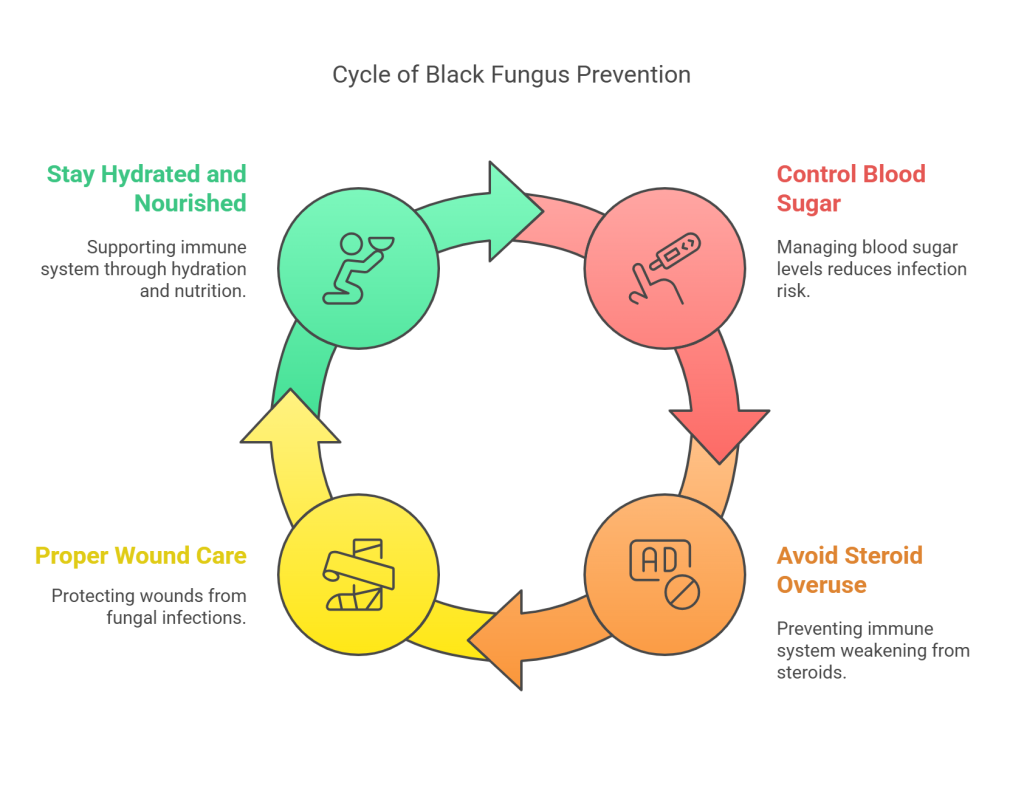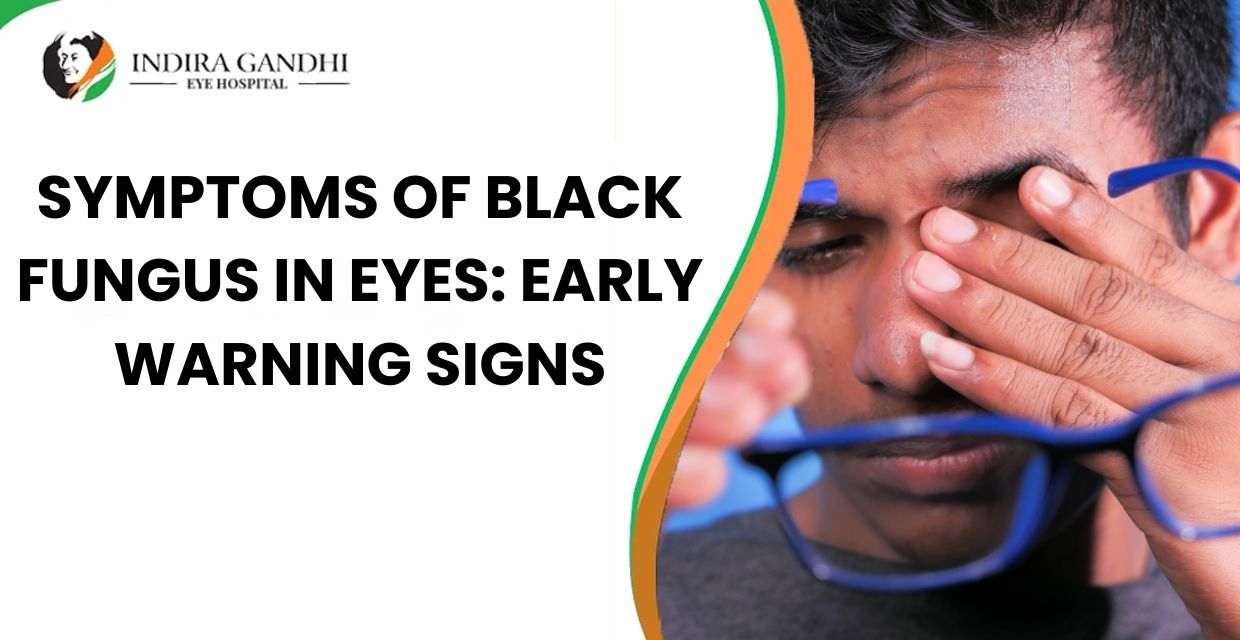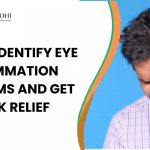|
Getting your Trinity Audio player ready...
|
Symptoms of Black Fungus in Eyes: Early Warning Signs :-In recent years, black fungus, also known as mucormycosis, has become a topic of serious concern in many parts of the world. This rare but severe fungal infection can affect different parts of the body, including the eyes. Black fungus in the eyes can be particularly dangerous, as it can lead to permanent vision loss if not diagnosed and treated early. In this blog, we will discuss the symptoms of black fungus in eyes, how to be safe from black fungus, and how to avoid black fungus altogether.
Understanding the signs of this condition is crucial, especially when it comes to eye health, as early detection can make all the difference. Let’s dive into what you need to know.
What is Black Fungus (Mucormycosis)?
Black fungus, or mucormycosis, is a serious fungal infection caused by a group of molds called Mucormycetes. These molds are commonly found in the environment, particularly in soil, decaying organic matter, and even in the air. While the infection can affect many parts of the body, the most common areas include the sinuses, lungs, and eyes.
In some cases, the infection can rapidly spread, leading to complications that can be life-threatening. Black fungus in the eyes is especially concerning because it can cause vision impairment and potentially lead to blindness if not treated promptly.
It is essential to note that black fungus is not contagious. It only affects individuals with weakened immune systems, such as those who have recently recovered from COVID-19, people with diabetes, or those undergoing immunosuppressive treatments like chemotherapy or steroids.
Symptoms of Black Fungus in Eyes

Recognizing the symptoms of black fungus in the eyes early is vital to ensuring proper treatment. The infection typically starts in the sinuses or lungs and can spread to the eyes. The early warning signs of black fungus affecting the eyes include:
1. Swelling Around the Eyes
One of the most common symptoms of black fungus in the eyes is swelling, especially around the affected eye. This swelling can be painful and may occur suddenly or progressively. The area around the eye may become red and tender to the touch, making it a key sign to look out for.
2. Redness in the Eyes
If you notice your eyes becoming unusually red, it could be a sign of infection. The redness is often accompanied by discomfort, pain, or irritation. If left untreated, the redness may worsen and spread to other areas around the eye.
3. Blurred or Reduced Vision
Vision problems are a significant symptom of black fungus in the eyes. This may include blurred vision, difficulty focusing, or even complete vision loss in the affected eye. The fungus can spread to the optic nerve or cause inflammation that impacts the eye’s ability to function properly.
4. Severe Eye Pain
If you experience severe eye pain, especially in combination with any of the other symptoms listed, it could be an indication of black fungus. The pain may feel sharp or constant and can worsen as the infection progresses.
5. Discharge or Blackish Crust
A black or dark-colored discharge from the eye, often accompanied by crusting or a foul odor, is another warning sign. The discharge may be thick and sticky, and the eye may feel gritty, as though something is stuck in it.
6. Proptosis (Bulging Eyes)
In severe cases, the infection can cause the eye to bulge outward. This condition, known as proptosis, occurs when the infection spreads to the tissues around the eye and creates pressure, causing the eyeball to protrude.
7. Loss of Eye Movement
If the infection spreads to the muscles controlling eye movement, you may experience difficulty moving the eye or loss of movement entirely. This can result in double vision or an inability to focus properly.
8. Darkening of the Skin Around the Eyes
In more severe cases, the skin around the eyes may begin to darken, taking on a purplish or blackish hue. This occurs when the tissue becomes necrotic (dead) due to the infection. This is a clear indication that the infection has progressed and requires immediate medical attention.
9. Fever
Although fever is not specific to black fungus, it is often present in the early stages of infection. A fever, especially when combined with any of the other eye-related symptoms, can be a sign that the infection is spreading and affecting other areas of the body.
10. Difficulty Breathing or Chest Pain
If the black fungus infection has spread to the lungs or sinuses, you may experience difficulty breathing or chest pain. This can occur along with the eye symptoms or separately, and it’s crucial to seek medical help immediately if these symptoms arise.
How to Be Safe from Black Fungus
While black fungus is a serious condition, there are steps you can take to protect yourself, especially if you have a weakened immune system. Here are some tips to help you be safe from black fungus:
1. Manage Underlying Health Conditions
Individuals with diabetes, those on immunosuppressive medications, and those recovering from COVID-19 are at a higher risk for developing black fungus. It’s important to keep underlying conditions, such as blood sugar levels, under control. Regular check-ups with your healthcare provider can help detect any potential issues early.
2. Avoid Exposure to Moldy Environments
Mucormycetes, the fungi responsible for black fungus, thrive in damp and moldy environments. Avoid exposure to areas with decaying organic matter, such as piles of leaves, compost, or moldy areas in homes or buildings. Wearing a mask in such environments can also reduce the risk of inhaling fungal spores.
3. Proper Hygiene
Maintaining proper hygiene is essential in preventing fungal infections. Wash your hands regularly, especially after touching surfaces that may be contaminated. If you’re handling items that could harbor mold, like soil or plant materials, use gloves to avoid direct contact with the fungus.
4. Avoid Self-Medication
People recovering from COVID-19 or other illnesses sometimes take steroids or immunosuppressive drugs, which can increase the risk of black fungus. However, these medications should only be used under the guidance of a healthcare professional. Always follow your doctor’s recommendations and avoid self-medication.
5. Seek Early Medical Attention
If you notice any symptoms of black fungus in the eyes, such as swelling, redness, or blurred vision, seek medical attention immediately. Early diagnosis and treatment are crucial to prevent the infection from spreading to other parts of the body.
6. Keep Your Environment Clean
Keeping your home and workplace clean can reduce your exposure to fungal spores. Use air purifiers and dehumidifiers to maintain clean, dry air. Regularly disinfect surfaces, especially those that are frequently touched.
How to Avoid Black Fungus

Preventing black fungus involves reducing the risk factors that contribute to its development. Here are some ways to avoid black fungus:
1. Control Blood Sugar Levels
If you have diabetes, managing your blood sugar levels is essential in reducing the risk of black fungus. High blood sugar weakens the immune system, making it easier for infections like black fungus to take hold. Regular monitoring and proper medication can help you maintain a healthy blood sugar level.
2. Avoid Steroid Overuse
While steroids are sometimes necessary to treat certain conditions, overuse of these medications can weaken the immune system and increase the risk of infections like black fungus. Always take steroids as prescribed by your healthcare provider.
3. Proper Wound Care
If you have any cuts or wounds, ensure they are cleaned and treated properly to prevent infection. Fungal infections can enter the body through open wounds, especially in individuals with weakened immune systems.
4. Stay Hydrated and Nourished
A healthy immune system is essential in fighting off infections. Eat a balanced diet, drink plenty of water, and get enough sleep to support your body’s natural defenses.
Frequently Asked Questions (FAQs)
What Are the Symptoms of Black Fungus in the Eyes?
Symptoms of black fungus in the eyes include swelling, redness, severe eye pain, blurred vision, blackish discharge, and darkening of the skin around the eyes. If left untreated, it can lead to permanent vision loss.
How Can I Be Safe from Black Fungus?
To be safe from black fungus, manage any underlying health conditions, avoid moldy environments, maintain proper hygiene, and seek early medical attention if you notice any symptoms.
Can Black Fungus Spread from Person to Person?
No, black fungus is not contagious and cannot spread from person to person. It only affects individuals with weakened immune systems.
How Can I Avoid Getting Black Fungus?
To avoid black fungus, control blood sugar levels, avoid overuse of steroids, take proper care of wounds, stay hydrated, and maintain a healthy immune system.
Is Black Fungus Treatment Available?
Yes, black fungus can be treated with antifungal medications and, in severe cases, surgery may be required to remove infected tissue. Early detection and treatment are key to successful recovery.
Conclusion
Black fungus in the eyes is a serious condition that requires immediate attention. Recognizing the symptoms of black fungus in the eyes early can prevent complications such as vision loss. By following preventive measures and seeking medical care at the first sign of infection, you can reduce the risk of contracting black fungus and protect your health. Stay vigilant, and don’t hesitate to reach out to your healthcare provider if you have concerns about black fungus.












